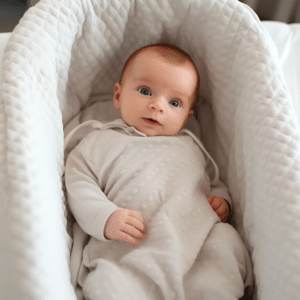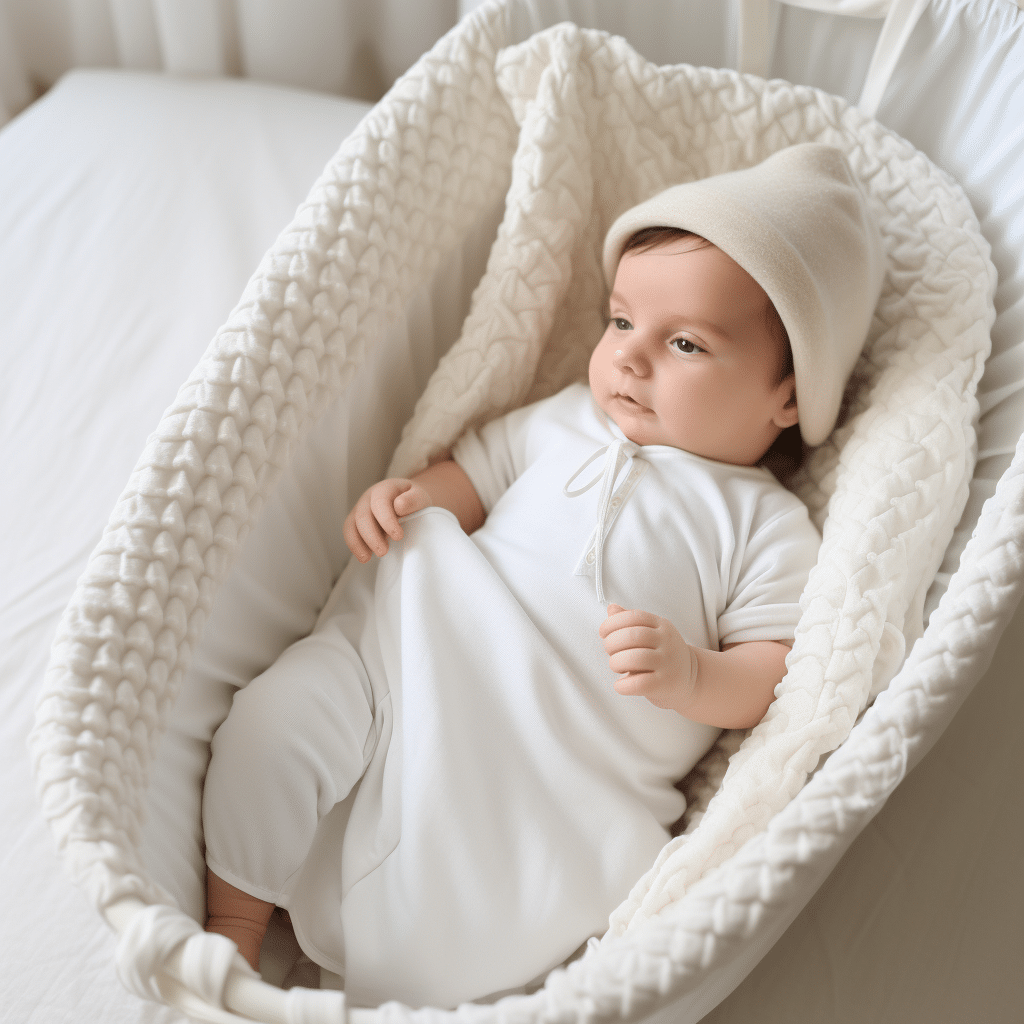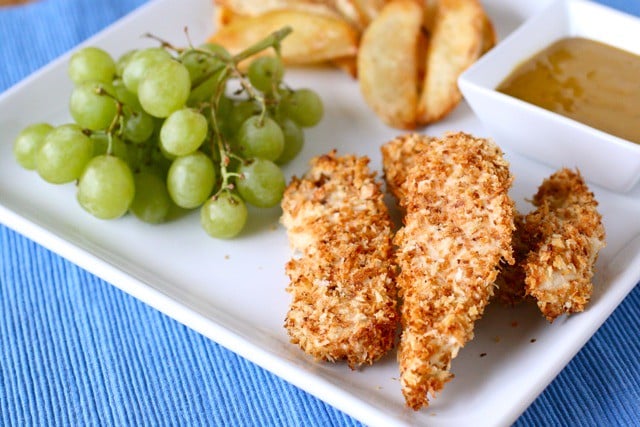Choosing Bassinet Sheets: Fabrics, Tips, and Safety
Choosing Bassinet Sheets: A bassinet is a bed specifically designed for a baby from birth to around 4 months and is supported by freestanding legs, a stationary frame/stand, a wheeled base, or a rocking base. A bassinet holds the baby in a cradle position and provides more mobility as they can be moved with ease from one place to another.

Do Bassinets Need Sheets?
A firm, well-supported mattress and fitted sheets are a must-have for a bassinet. Note, a baby can continue using a bassinet up to the time they get to 20 pounds or when they start rolling whether before or after 4 months. They are used as a temporary sleep solution before the baby is moved to a crib. The frame can be made of plastic, wood or metal with low side walls made of either mesh or cloth. Pediatrics recommend mesh fabric because it is breathable, and thus allows airflow.
How to Choose Bassinet Sheets
Getting a properly fitting sheet should be your top priority. Choose elastic Choosing Bassinet Sheets sheets that are deep enough to fit over all four corners of the mattress without slipping but tight enough that it can’t fold or bunch. When the sheet fits well, it reduces the risk of suffocation from the sheet coming off the mattress during sleep. Children have naturally delicate skin, prone to irritation and some developing eczema, rashes, and dry skin. Therefore you should choose fabrics that reduce skin irritation, particularly for newborns. A fabric that’s breathable, soft to the touch, and natural, such as bamboo, merino wool, or cotton are great choices for sheets. Synthetic fabrics are also available including flannel and polyester. The fabric of choice should allow frequent washing if possible daily.
A Comparison of Fabrics Used in Bassinet Sheets
| Description | Bamboo | Cotton | Flannel | Polyester | Merino wool |
| Pros | -So soft and buttery -Smooth and round, causing less irritation -Extremely breathable, sweat-wicking, temperature-regulating -Eco-friendly material -Antimicrobial properties
| -Breathable Low-maintenance care -Keeps your child cool in the summer and warm in the winter -Hypoallergenic Generally inexpensive
| -Perfect for winter and cold temperatures -Soft and cozy -Durable and thick
| -Cheap -Easy to find -Flexible and doesn’t tear or rip easily
| -Non allergenic -Durable Temperature regulating |
| Cons | -Expensive -Some companies do not use 100% bamboo or organic materials
| -Depending on the thread count, cotton sheets can be scratchy at first -Wrinkles easily
| -Not a breathable -Should not be used in warmer months -Baby can overheat or get sweaty
| -Low breathability due to synthetic material -Not great for warm weather
| -Expensive -Some companies do not use 100% organic materials. |
| Fabric | Natural | Natural | Synthetic | Synthetic | Natural |
| Durability | Durable | Durable | Fairly durable | Fairly durable | durable |
| Machine washable | Washable | Washable | Washable | Washable | Washable |
Factors to Consider When Buying a Bassinet
The following factors should guide you when purchasing a bassinet
- Breathable sides. Mesh allows airflow and thus is preferable to cloth.
- Fabrics. Natural, untreated fabrics are a better choice for sensitive, delicate baby skin.
- Portability. The ease of folding or disassembling determines the ease of storage.
- Mattress firmness and support. A firm well supported mattress aids in the prevention of Sudden Infant Deaths (SIDS). In addition, there should be no gap between the edge of the mattress and the sides of the bassinet to prevent the baby from getting trapped.
- Beddings. The sheets should be well-fitting. Do not add pillows, quilt, blankets, and bumper pads to the bassinet. These additions can cause suffocation in case they cover the sleeping baby.
- Bassinet style. There are different styles including; Travel, Moses Basket, Co-sleepers, Rocking, and Classic stationary.
- Stability. Consider a stable bassinet to minimize the risk of toppling over.
- Height. A good bassinet should get to the parent’s waist or higher for ease of placing the baby. It should allow a cesarean mother to place a baby without strain on the incision wound.
- Weight and age limits. The majority of bassinets have an age limit of 4-6 months and a weight limit of 15-20 pounds.
- To rock or not. Rocking increases the chances of toppling in case of a little move or rollover. Additionally, weight shifting around in a rocking bassinet could tilt the bassinet and your baby could become trapped against one side and risk suffocation.
Advantages of Using a Bassinet
- Portability. It is easily portable due to its lightweight.
- Convenient for small living spaces
- Cost friendly
- Great for bed sharing
- Easy and quick to assemble
- Easy to put your baby in and take them out.
- It can be used in a stroller

Safety Tips While Using a Bassinet
- Always use a firm mattress and fitted sheet with no gaps between the mattress and the sides.
- Ensure it is stable to avoid toppling
- Stop using it when the baby starts rolling to reduce the chances of fall-offs.
- Never leave a baby unattended in a rocking bassinet.
- Remove toys, pacifiers with cords, quilts, bumper pads, blankets, and any other item from the bassinet before putting the baby to sleep. This reduces the risk of suffocation and choking.
- Dress your baby in a wearable blanket or warm pajamas instead of covering him in a blanket. Overheating is a risk factor for Sudden Infant Death Syndrome (SIDS.
- Ensure the wheels of a movable bassinet are always locked when stationary.
- Always use natural fabrics that are certified safe for babies.
- Place your baby on his back in a bassinet. Most Sudden Infant Deaths (SIDS) cases occur during the first six months of a baby’s life.
- Buy a new and a safety-certified bassinet. Avoid buying used ones.
- Place your baby’s bassinet away from hazards such as windows, patio doors, lamps, candles, electrical plugs, corded baby monitors, extension cords, and other small objects.
Choosing Bassinet Sheets, the safety and comfort of your infant while asleep are vital. Well-fitted, soft, and breathable sheets ensure your little one sleeps safely, comfortably, and for longer. Studies have shown that kids who regularly get an adequate amount of sleep have improved attention, behavior, learning, memory, and overall mental and physical health.






